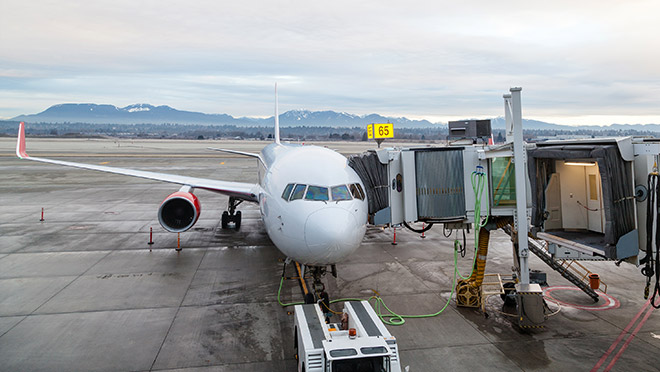BC Hydro gets green light to electrify B.C.

New programs to help industrial customers reduce greenhouse gas emissions
Infrared heating for curing and drying. Passenger jets plugged into electricity when they're on the ground. Conveyor belts replacing diesel-powered trucks at mining sites.
These are a few of the ideas BC Hydro, via an enriched mandate from the Government of B.C., is exploring as part of B.C.'s climate action strategy to limit carbon emissions in B.C. But nothing will happen without a strong business case for such changes.
"Customers are very interested in these ideas," says Michael Travers, who manages BC Hydro's Alliance of Energy Professionals. "But each opportunity needs to be supported by a strong business case. Do the economics support the changes? And in some cases, the technologies that support the change may not be familiar to our customers, or may need to be proven out for operation here in Canada."
BC Hydro has been exploring scenarios for "low-carbon electrification" and how the utility can support customers to identify and investigate opportunities. In December, the B.C. Government's CleanBC announcement called out BC Hydro's role as a key player in a strategy to reduce greenhouse gas emissions by shifting homes, vehicles, industry and business off burning fossil fuels and toward greater use of clean B.C. electricity.
"The personal passenger vehicle may be the most widely recognized example of an opportunity for electrification, but there are lots of opportunities outside of our roads," says Travers. "We've now finalized and approved internally funding to put some new programs in market to help customers identify, investigate, and implement some of these lesser known opportunities."
Customers' sustainability objectives can be the tipping point
The sustainability objectives of businesses, particularly those with commitments to carbon emission reduction objectives, can be the key ingredient in the decision to switch from fossil fuels to electricity.
"Ultimately if a company can make a business case out of it, they'll move on it," says BC Hydro senior industrial programs manager Kevin Wallace. "And one of the biggest factors is the pricing of carbon. They can save carbon tax by eliminating fossil fuels in some of these operations.
"In a lot of industrial applications, switching from fossil fuel to electric is a more efficient use of energy and can reduce your costs. And therefore you just make that change. Quite often those align well with your company's environmental objectives. That's just good energy management practice."
Non-road transport the focus for industrial customers
Electric vehicles and heat pumps are the electrification focus on the residential side, while space and water heating dominates commercial offers. But there's a wider world of opportunities for B.C.'s industrial customers.
"We'll be looking at any fossil fuel reduction opportunities that can be electrified in industrial processes," says Wallace. "And we're looking at non-road transportation, such as at ports and airports, and in mining."
Ports use a variety of equipment that rely on diesel and other fossil fuels, ranging from forklifts, to loading trucks, and cranes – a lot of it used to move shipping containers around. At airports, there are unique forms of ground support equipment, including machines that assist docking of passenger planes, and buses carrying passengers from planes where customers disembark on the tarmac.
Another big initiative at airports is electrifying as much of the needs of aircraft, notably lighting and air conditioning, while they're on the ground. Much of those needs are currently powered by jet fuel or diesel, and BC Hydro is working with the likes of Vancouver International Airport to explore how to make it cost-effective to plug in to electricity more often. It's very much like BC Hydro's shore power initiative used to power cruise ships while they're docked in Vancouver's harbour.
"The technology is there," says Wallace. "What's missing is the business case, and that's what we're working on."
All-electric mine in Ontario a sign of things to come
Non-road transport electrification also holds great potential in the mining sector, where options include electric truck and electric conveyors – which transport materials over shorter distances – to replace diesel-powered trucks. There's already a template out there, with Goldcorp's Borden Mine in northern Ontario set up to be the world's first all-electric mining operation, thanks to an underground fleet of battery-powered jumbo drills, roof bolters, and loaders.
On the marine side, Norway has made a significant move to electric ferries for shorter routes, including five new 50-car ferries using lithium ion battery storage systems developed by Corvus Systems of Richmond, B.C. While BC Ferries has said all-electric ferries aren't yet planned for B.C. waters, they are looking at diesel hybrid ferries that would rely on Corvus Systems technology.
New program orientation for Alliance members
Some customers have shelf-ready or near shelf ready projects, and they are ready to determine if they can make the business case work with the newly available low carbon electrification project implementation funding. Others haven't had the chance to identify and do a deep dive to explore the feasibility of potential projects.
That's where Alliance members can step in, through energy study support, to develop new projects as well as project implementation to help customers reach business goals while reducing greenhouse gas emissions.
Orientation training specific to our new low carbon electrification programs is available to Alliance members. If you're interested in learning more, register here for our upcoming session on Tuesday, April 30, 2019 at the Executive Plaza Hotel in Coquitlam.